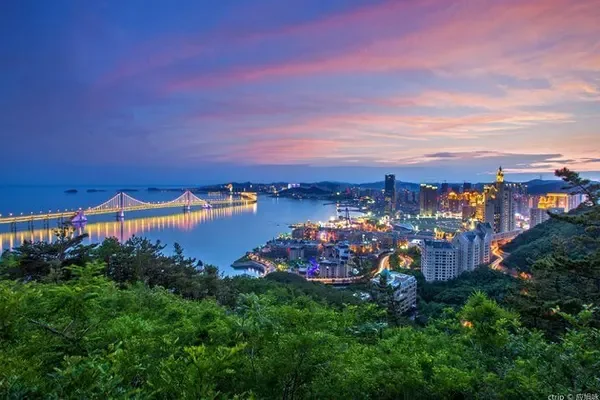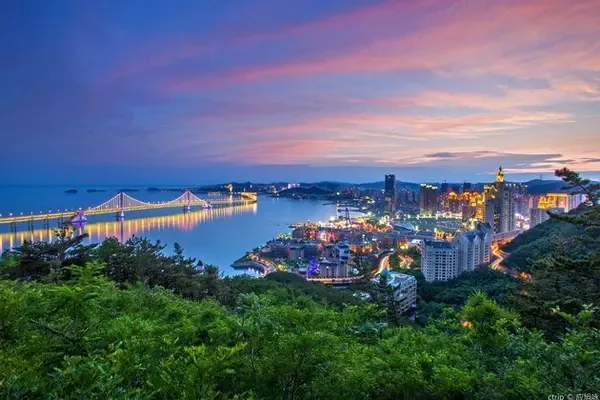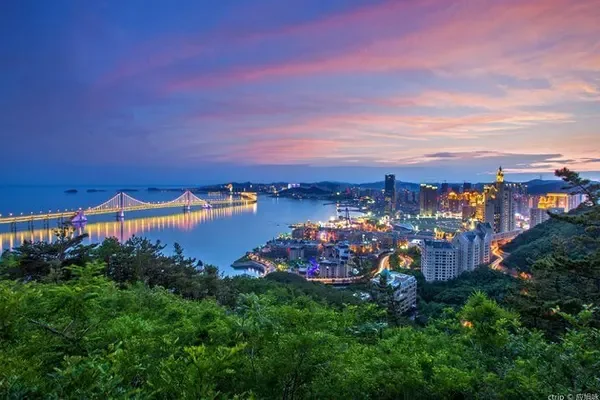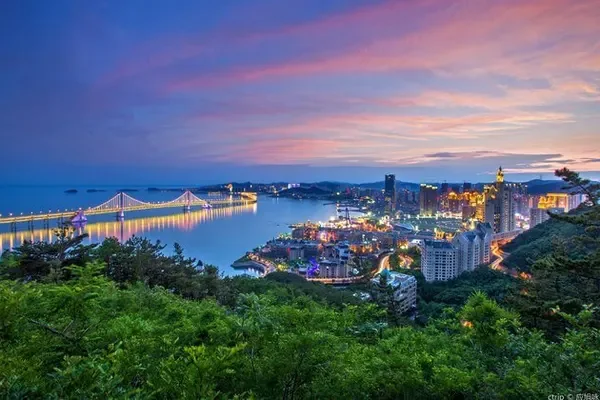The photos in this article are all taken by the author of "Black and White Touch", all rights reserved, and unauthorized use is strictly prohibited!
grandma
In ancient times, the mother of Emperor Yao dreamed that there was a fairy mountain on the southeast coast, with towering stone peaks, majestic and beautiful, just like a fairyland, mother Yao and Emperor Yao took a boat across the sea to find the fairy mountain. The boat sailed for several months, but there was still no trace. One day, there was a heavy fog, and everyone on board panicked. They knelt down and prayed. Soon, the wind blew away the fog, and a high mountain stood in front of them. Yao's mother was very happy when she saw that the mountain was steep and majestic, exactly the same as in the dream, so she lived in a cave.
One day, when Yao's mother went to the mountain to pick bluegrass, she found a very special small tree with crystal clear leaves, which was very cute. She took off a few pieces and chewed them, which were very fragrant and refreshing. So she picked leaves to make tea, named "Lvxueya" (later the ancestor of Fuding white tea). Whenever villagers in the mountains visit the cave, she treats them with "green snow buds". Mother Yao also cured many children suffering from measles with "Lvxueya". After her death, the local people were grateful for her kindness, built a stone tomb to bury her relics, molded a portrait, and honored her as "Taimu Empress", and this fairy mountain in the dream is also known as "Taimu Mountain".

The picture above shows the sculpture of the Taimu Empress on the square of the Yuhu Tourist Area at the foot of Taimu Mountain. It seems to be walking slowly against the sea breeze, with her head slightly lowered and her kind eyes slightly open, always paying attention to all living beings at the foot of the mountain. Ganoderma lucidum spreads love to the world, holds the dust whisk in its right hand, and sweeps away the miasma and fog in the world.
Taimu Mountain is located in Fuding in the northeast of Fujian Province. Like Fuzhou in the "Land of Blessings", the name is also full of blessings - "Land of Fortune, Land of Heyday". About ten kilometers to the east side of Taimu is the East China Sea, which is "blessed like the East China Sea". Climbing the mountain to overlook the sea is a major attraction of visiting Taimu.
Taimu Niangniang Statue Square is an ideal place to watch the sea and watch the sunrise. Standing here and overlooking the front, you can have a panoramic view of Qingchuan Bay and Fuyao Islands. It's just that my luck may have been spent in southern Fujian and central Fujian. The day I came to eastern Fujian was foggy, not to mention the sea in the distance, and the nearby stone peaks could not be seen clearly. Shifeng is another highlight of Taimu Mountain given by granite.

This is not the first time I have seen the mountains in the fog. Traveling is like this. Three points depend on planning, and seven points are destined. The condition is such a condition, we can only embrace regret and see what we can see as steadily as possible! This is the attitude I have always advocated - "Accept what cannot be changed, change what I can change", I have missed the sun, don't miss the stars again.
Taimu Mountain is known as the "immortal capital on the sea". Strange rocks in the mountains, like people and things, are uncannily crafted; caves under the peak, the caves are connected, criss-crossing, twists and turns are deep, like an underground labyrinth, which is breathtaking.

Taimu Mountain includes Yuhu, Yingxiantai, Yiyiwa, Xiangshan Temple, Baiyun Moxiao, Wulonggang, Guoguang Temple and other large tourist areas. Take a bus from the visitor center to the parking lot of Yuhu Tourist Area, and pay homage to Taimu. , we continue to climb the mountain on foot to explore the wonders in the phantom fog.
Not long after going up the mountain, there are two iconic scenic spots in Taimu Mountain-Eighteen Arhats and Husband and Wife Peak, which are pictographic landforms of granite peaks, but as mentioned above, they cannot be seen in the fog. However, as the business card of Taimu Mountain, Husband and Wife Peak has to be displayed, so I found a picture from the Internet and pasted it below. Does it look like a couple embracing intimately?

Going forward, I saw a stone pagoda. This is the Langa Pagoda built in the Qianfu period of the Tang Dynasty. It has a seven-level octagonal solid stone structure, which is rare in China.

The pagoda goes west to Guoxing Temple.
Guoxing Temple was first built in the fourth year of Qianfu in Tang Dynasty (877). It is surrounded by water on three sides and mountains on one side. There are seven large stone pillars standing on the ground. Incomplete inscriptions. It was rebuilt during the period of the Republic of China, and what we see today are the Daxiong Hall, the Taimu Hall, and the monk's house.

From Guoxing Temple to Yingxiantai, you need to climb Sagong Ridge. This is a stone road with towering ancient trees, simple and quiet, and there are many cliff stone carvings along the road. Sagong Ridge was built in 1929. It was initiated by Sa Zhenbing, the founder of the modern Chinese navy and the former chief of the Navy of the Beiyang Government, soliciting donations. It was called "Sagong Ridge" in ancient times.

On the east side of Sagong Ridge, there is another plank road to welcome immortals. On the way, there is a pool of clear water called "Baolongtan". The pool is quiet, elegant and leisurely. Taimu Mountain has a lot of rainfall, and the rainwater from Baolong Peak converges into this depression and gathers into a pool. There is Yongcui Pavilion on the side of the pool, which means that the mountains here are as green as waves.

Not far from Yingxiantai, there is a strange stone, which resembles a heart, entwined with vines, and surrounded by tree roots like blood vessels. It is called "the heart of the grandma".

There are many mountains to climb, and strange rocks and strange scenery are no surprises, but Taimu Mountain still gave me some surprises. The grandma's mind on the top is one, and the gourd hole on the bottom is another.
The gourd cave is formed by the gravity collapse of granite, with a total length of more than 1000 meters, and the shape of the cave looks like an upside-down gourd. Inside the cave, there are twists and turns, staggered light and shade, with 13 patios and 7 halls, dotted with rare plants such as ancient vines, nanmu, and konggulan. During walking, you need to use various movements such as drilling, climbing, squatting, sideways, etc., and you can't see your fingers in dark places, and you can't get through narrow places if you are a little fatter, and you even need to crawl forward in short places! It is a double test of courage and physical strength.

Some places are at stake:

Some places are dark:

I don’t know if you guys have played "Tomb Raider", the experience I have given to Calabash Cave is like moving the game into a real geocentric adventure!
At the end of the hole, there is a pillar supporting the sky. Tianzhu Peak - a 40-meter-high stone pillar stands in front of you. What's interesting is that its top is formed into two stone eggs along the horizontal joints. Running to the mouse is called "golden cat rushing to the mouse".

There is another strange stone on the west side of Tianzhu Peak—the TV screen stone. Among the strange stones named after natural ancient rhymes, a "modern home appliance" suddenly appears, which feels a bit inconsistent, but when you see this stone, you feel It's so vivid, I don't know what else it can be called besides "TV screen".

Going forward to Lanxijian, it is said that the grandmother lived in seclusion in the mountains, planted indigo for a living, and often dyed cloth by the stream, so the clear stream became blue and green. "Taimu Mountain Records" contains: "Every year in August, the water turns blue."

Not long before, there is another exciting landscape - a line of sky. Just now there is a "line of sky" in Hulu Cave. I have also drilled a line of sky in other famous mountains before, but compared with the one in front of me, it is not too spacious! This is the narrowest line of sky in China, more than 60 meters long, more than 40 meters high, and the narrowest point is less than 20cm. If you are a little plump, you can't pass it sideways! (Don’t worry about detours if you can’t pass, there is another convenient road next to it) If you don’t believe me, look at the picture below. If there is no junction between light and dark, you may not even find the road!

Because it is too narrow and high, little sunlight shines through, and you need to use a flashlight when passing through. It is cramped and steep. Even if you are fit enough and have no guts, it is not recommended to challenge.

Continue on to a tile central square, where there is the Grandmother Pagoda built in the Tang Dynasty. Behind the tower is the Grandmother Hall, which is said to be the place where the Grandmother attained enlightenment and ascended to heaven.

The Lvxueya ancient tea tree mentioned above is also planted here, from which Fuding's famous tea, Baicha, originated. "Bamin Xiaoji" records: "There is green snow bud tea in Taimu Mountain, which is called Pekoe today. It has a good fragrance and color, and the tea produced in Hongxue Cave is the best." , The name of the cave is taken from Su Shi's poem: What is life like everywhere? It should be like Feihong stepping on slush. Behind Hongxue Cave is Tongtian Cave, which is a famous scene of Taimu Mountain.

Not far ahead, there are two wonders - a tile temple and a suspended copper temple.
The Hanging Copper Hall is backed by Jiuli Chaotian Peak, with Feixian Peak on the left and Lianhua Peak on the right. The palace in the sky is full of imagination.

A piece of tile temple is between two collapsed rocks, and there is a thin plate boulder covering it like a tile, forming a hut, hence the name "a piece of tile temple".

Go forward and come to Hongxue Cave. Huge stone eggs are stacked on top of each other in the valley. There is a large space between the stone eggs, forming a stacked stone hole. When passing through it, there are huge stones pressing on the top, fluctuating high and low, sometimes wide and sometimes narrow, Twists and turns, don't have a lot of fun.

Behind Hongxue Cave is Tongtian Cave, which is a slightly wider "line of sky". Looking up at the top of the valley, there are many rock blocks gathered in mosaic, stacked or suspended styles, which is more thrilling. Therefore, the road is narrow and steep, like climbing steps to the sky, leading directly to the Nantian Gate, hence the name "Tongtian Cave". Tongtian Cave is next to Qixing Cave, more than 40 meters long and less than one meter wide. Looking up in the cave, it seems that seven stars are dotted in a line of sky, and the light shines through the stones, giving a dreamy look.

From a piece of tile to the Xianqiao plank road of Xiangshan Temple, you can see "boys worshiping Guanyin", "nine carps facing the sky", "two Buddhas talking about scriptures" and other strange peaks and rocks from a distance. You can't see anything in the fog, and there is light rain. Arrived at Xiangshan Temple in one go.
Xiangshan Temple was first built in the Ming Dynasty on the banks of Jiuli Lake. There are five hundred Luohan halls, rhinoceros caves and other scenic spots in the temple. There are many orchids around the temple, and every flowering season, the fragrance of orchids drifts with the wind, hence the name "Xiangshan Temple". The temple building is small and exquisite, and the environment is quiet. The nine carp lake reflects the wonderful scene of nine carp facing the sky, and the lake and mountains are picturesque. When the weather is fine, Taimu Mountain is the most rare place for landscape photographers.

Walking along the Tuojiuling Mountains, you come to the Echo Gallery, which is also called "Three Responses". Standing in the pavilion, facing the Nine Carp Chaotian Peak, and shouting quickly, you can hear the clear and recognizable echoes that turn back three times. Also known as "Grandma's sound transmission".

Tuojiuling leads to Baiyun Moxiao Tourist Area, where there are many cultural relics, such as Baiyun Temple, Moxiao Temple, Mani Palace and many cliff stone carvings in the Tang Dynasty. Baiyun Temple, actually Moxiao Temple, was built by Zen Master Baiyun in the 13th year of Tang Kaiyuan. According to records, "there are three Buddhist halls surrounded by monk buildings, all of which are extremely high." What I see now was rebuilt later, but the architectural style remains the same.

The highest peak of Taimu Mountain - Fuding Peak with an altitude of 917.3 meters is also in this area. The top of the peak is narrow, only about 6 meters in diameter, shaped like an overturned top. When the weather is fine, you can overlook Qilingang, Longzhugang and Wulonggang from a distance, and it is also the best place to watch the sunrise on Taimu Mountain, that is, "No. 1 Sun Observation Terrace".

From the west of Fuding Peak to the exit, you need to pass through Wulonggang. At this time, it is close to 6 o'clock in the afternoon, and the surrounding area has gradually become dark. Wulonggang has a total length of 1380 meters, and there are scenic spots such as the sea view platform, fairy cave, Yuezhang platform, Tiansheng bridge, etc. It could have been as far as the eye can see, the sky and the blue sea, unrestrained and heroic, or look at the mountains and mountains, heroic and passionate, but when night falls, what is left for me The impression is only the steep and steep mountain road and the trembling of the frightened birds in the dark forest...

After a few months, I climbed another dangerous mountain alone at night, and relived this horror. I suddenly understood why stray cats and dogs are so sensitive and restless, why the antelopes in Hoh Xil are so timid and alert, and they should stay away from the concrete forest. Familiarity and protection, when walking in the invisible unknown, people will also seem to cheer up, maximize all sensory functions, and feel like a frightened bird when there is a slight disturbance.

There is no sea on Taimu Mountain, but 50 kilometers to the south, in the Beiqi tidal flat in Xiapu, I saw a different "the sun also rises".
Xiapu
Xiapu is China's "Hometown of Kelp" and "Hometown of Seaweed". Because of its rich seafood, Xiapu's 480-kilometer coastline has bamboo poles for drying kelp, hanging seaweed, and fishing with seine nets. The fishing boats, the ebb and flow of the tidal flats, and the rising and setting sun together constitute Xiapu's most beloved scenery for photographers, and it also attracts countless tourists from all over the country to watch the sunrise and sunset.
(Xiapu under the lens of the photographer, the picture comes from the Internet)

There are many shoals in Xiapu, some are suitable for watching the sunset, and some are suitable for watching the sunrise. The Beiqi tidal flat I went to is located in Beiqi Village, which is closer to the city, and it is also nearly 10 kilometers away from the hotel. Fortunately, there are shared battery cars everywhere, and we leave before dawn, because Beiqi Village is beyond the parking range, and it takes a while to walk.

It was quite foggy that day, and the sky was dyed red. The sun hadn't seen its rays yet, and when it came out of the clouds, it was already a lot higher than the sea level. Watching the sunrise together was an elderly couple and a group of young students, both of whom expressed slight regret. The boatman said that being able to see the sun is not bad, and it is not uncommon to see the sun all the time. Although I couldn't see the wonderful scene of the sun jumping out of the sea level, the warm yellow tidal flats smudged by the rising sun also made up for the tiredness and hard work of a group of people running around at dawn.


The sun is getting higher and higher, the turbid mist is gradually disappearing, the nearby grass is bright and picturesque, and the distant mountains are ethereal.

After a while, the sky was blue, and the county opened a day full of vitality. The ancient churches and temples, the novel museums and the lush banyan tree at the entrance of the village have their places, and the farmers in the village and the migrant workers in the city go their separate ways.. ....

And we will not stop running all the way, the next stop - Wuyishan!




